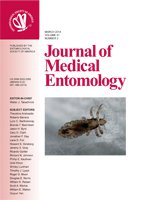In southern Punjab, Pakistan, Muzaffargarh District is known to have insecticideresistant Anopheles and drug-resistant Plasmodium spp. In this part of the country, five anopheline mosquitoes, Anopheles stephensi Liston, Anopheles culicifacies Giles, Anopheles fluviatilis James, Anopheles superpictus Grassi, and Anopheles subpictus Grassi (Diptera: Culicidae) are known as malaria vectors. Among these, An. culicifacies is the primary and An. stephensi is the secondary malaria vector. Outbreaks of malaria usually occur after rainy episodes. We conducted field surveys to collect field strains of An. culicifacies and An. stephensi mosquitoes from different areas of Muzaffargarh District. We determined susceptibility and irritability levels of their adult stages to the discriminative dose of different insecticides. For this purpose, we used World Health Organization's established criteria for assessment. Mortality was calculated after 1 h exposure and for 24 h recovery period for various insecticides. An. stephensi was found to be significantly resistant to dichlorodiphenyltrichloroethane (DDT, an organochlorine), dieldrin (a chlorinated hydrocarbon), and malathion (organophosphorus), with lethal times (LT50) of 83.17, 52.48, and 37.53, respectively. However, the species was significantly sensitive to permethrin, deltamethrin (pyrethroids), and fenitrothion (organophosphate) with LT50 of 2.85, 2.34, and 13.18, respectively. Among these, permethrin showed more promising results against adult An. stephensi. When analyzed for irritancy, we found that among pyrethroids, permethrin was the most irritant insecticide for both An. stephensi and An. culicifacies. DDT and dieldrin showed least irritancy with 0.42 ± 0.08 and 0.77 ±0.12 takeoffs per minute per adult, respectively, against An. stephensi. The mean number of takeoffs per minute per adult with permethrin showed significant irritancy for permethrin when compared with DDT. Based on this study, we conclude that the use of organochlorine (DDT) and chlorinated hydrocarbon (dieldrin) should not be reintroduced in Malaria Control Programme in Pakistan until there is enough evidence to do so at any stage in future, and the use of pyrethroids should continue, with preference to permethrin for better control of malaria by indoor residual spraying.
How to translate text using browser tools
1 March 2014
Susceptibility and Irritability of Adult forms of Main Malaria Vectors Against Insecticides Used in the Indoor Residual Sprays in Muzaffargarh District, Pakistan: A Field Survey
Saleem M. Rana,
Ejaz A. Khan,
Aashifa Yaqoob,
Asma A. Latif,
Mudassar M. Abbasi
ACCESS THE FULL ARTICLE
It is not available for individual sale.
This article is only available to subscribers.
It is not available for individual sale.
It is not available for individual sale.

Journal of Medical Entomology
Vol. 51 • No. 2
March 2014
Vol. 51 • No. 2
March 2014
Anopheles culicifacies
Anopheles stephensi
insecticide
irritancy
susceptibility




